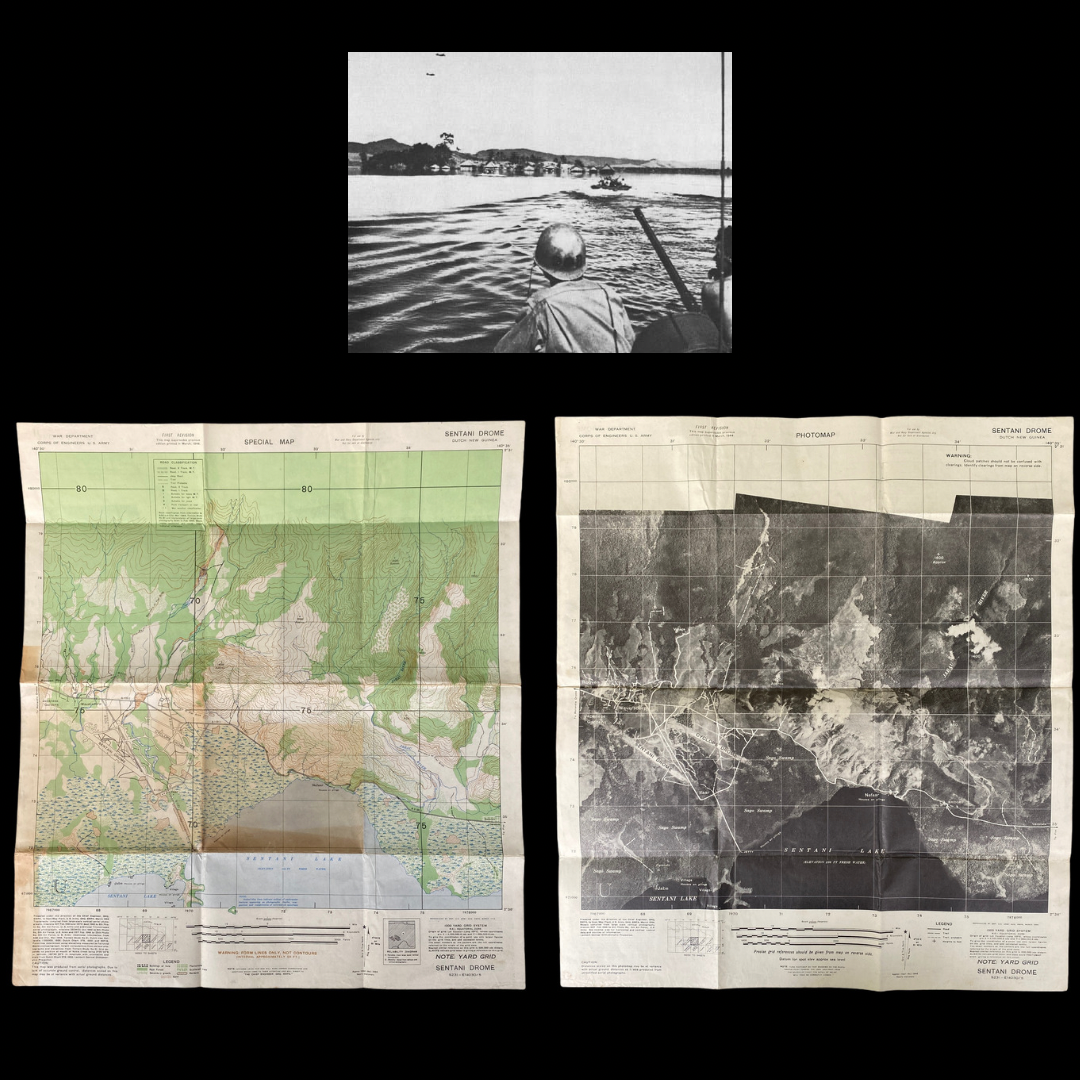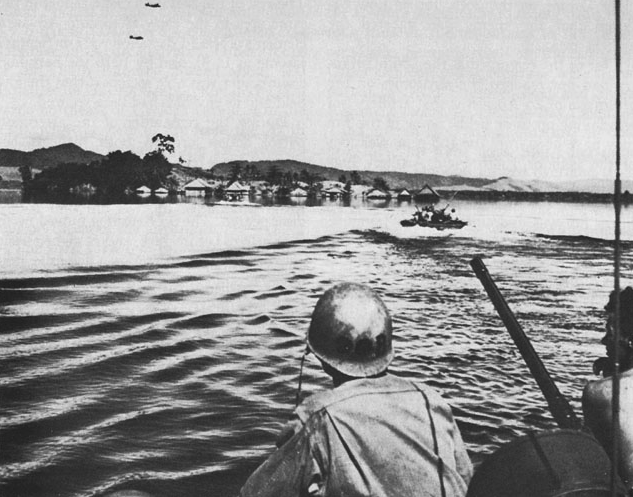RARE WWII 1944 Double Sided Operation Reckless Task Force "Sentani Drome" Infantry Combat Map

























RARE WWII 1944 Double Sided Operation Reckless Task Force "Sentani Drome" Infantry Combat Map
Size:
Prepared under the direction of the Chief Engineer this extremely rare double side infantry movement and rare ‘AERIAL SUPPORT PHOTO’ map was used in support of the Operation Reckless Task Force Amphibious movement on Lake Sentani and the capture of the Japanese-held Sentani Drome and Cyclops Drome. One of the most famous pictures of the Operation Reckless campaign shows LVT’s crossing Lake Sentani with the 9th Air Force B-25’s flying overhead.
Titled “Sentani Drome - Dutch New Guinea” This map was constructed from large scale vertical area photograph missions 43Y (February 1944) and 267X (September 1943) by 8th Photo Squadron, 5th Air Force with U.S. Army and additional Tri-metorgon aerial photography captured on missions 282W (October 1943) by 8th Photo squadron, 5th Air Force and 56Y (February 1944) by 25th Photo Squadron 5th Air Force. This map also features a rare ‘PHOTO MAP’ on the backside showing a realistic view of the Japanese airfield and terrain from the air. These backside ‘PHOTO MAPS’ are not common and are generally reserved for special divisions and operations.
This map was printed a month before (March 1944) of the D-Day amphibious landings in Tanahmerah Bay (April 1944). The ‘Road Classification and ‘Legend’ were vital to mission success as the infantry navigated the land from RED BEACH 1 and RED BEACH 2.
Amphibious Movement on Lake Sentani:
Colonel Newman's plans for the 25th envisaged using his entire regiment in a combined amphibious and overland advance to the airfields, a maneuver now possible because the 34th Infantry could free 186th Infantry units from guard duties along the line of communications back to Pim. Colonel Newman ordered the 3d Battalion, 186th Infantry, to move west along the main road to Nefaar, six and one half miles beyond the night bivouac area. The 1st Battalion was to load on LVT's at the jetty which had been captured the previous afternoon. From that jetty, the troops were to move by LVT over Lake Sentani to a point on the shore west of Nefaar and, upon landing, help the 1st Battalion to secure that village. Two companies of the 2d Battalion were to clear scattered enemy troops from high ground on the right flank, whence the Japanese had harassed the battalion's night bivouac. As soon as this task was accomplished, the 2d Battalion would reassemble as regimental reserve and follow the 3d along the main track toward Nefaar. Company I had not reached the 3d Battalion the previous day and was therefore ordered to operate with the 1st Battalion, at the perimeter of which it had arrived just before dark. Company B was lent to the 3d Battalion to bring that unit up to full strength for the advance west.
LVT's of the 2d Engineer Special Brigade had now moved up to the jetty which the 3d Battalion had captured the previous day. There, at 1000, two companies of the 1st Battalion loaded on the amphibians and departed for Nefaar. No Japanese fire from the shores of Lake Sentani greeted this landlocked amphibious maneuver, and at 1150 two companies landed at Nefaar. The remainder of the 1st Battalion moved by LVT to Nefaar later in the day and at 1530 the 3d Battalion reached that village after an uneventful march overland. The 2d Battalion closed on the village shortly thereafter.
Vigorous patrolling north and west of Nefaar characterized action the rest of the afternoon, during which only slight resistance was encountered. Expected strong enemy opposition had not as yet materialized, but before dark a platoon of Company A made a brief reconnaissance of Cyclops Drome, most easterly of the three Japanese fields on the north shore of Lake Sentani, and reported evidences of considerable enemy movement and strong defensive positions. Despite these reports, Colonel Newman was confident that his troops would have little or no difficulty in securing Cyclops
Drome on the 26th, for he now believed that the enemy had vacated the airfield area.
One of the reasons that the 186th Infantry had not reached the airdromes on the afternoon of 25 April was that artillery fire was falling on those fields. Some of this fire may have been from the 155-mm. weapons of the 11th or 168th Field Artillery Battalions, emplaced on the 24th Division's beaches at Tanahmerah Bay, but other artillery fire was undoubtedly from Japanese dual-purpose weapons dug in north of the airfields. Whatever the case, communications difficulties prevented the fire from the 24th Division's area being stopped before the time came for the 186th Infantry to set up night defenses. The 1st Battalion bivouacked about 1,700 yards west of Nefaar and placed outposts in high ground 700 yards north of the main trail. The 3d Battalion went into position about 1,000 yards behind the 1st, while the 2d remained at Nefaar for the night.
For the morrow, Colonel Newman ordered the 1st Battalion to seize the northwestern half of Cyclops Drome. One company of the 3d was to secure the southeastern part of the field and the remainder of the battalion was to act as general reserve. The 2d Battalion was to move by LVT from Nefaar to another jetty located about 2,000 yards southeast of Sentani Drome and the village of Ifaar. Pushing rapidly up a trail from the jetty to Ifaar, the battalion was to seize that village and Sentani Drome.
The 1st and 2d Battalions moved out as planned shortly after 0800 on the 26th. By 1040 the 1st Battalion had secured Cyclops Drome against no opposition. About 1000, Companies F and G of the 2d Battalion landed against scattered rifle fire at the jetty below Ifaar, a mile overwater from Nefaar. The rest of the battalion came ashore in the same area in the early afternoon. Advance elements of the 2d Battalion were on Sentani Drome at 1130, and by 1215 the battalion commander was able to report that the airfield and its environs had been secured.
During the remainder of the afternoon patrol action around both airfields accounted for a few Japanese stragglers. Opposition throughout the day had been conspicuous by its absence--the Japanese had disappeared. The 3d Battalion moved up to the airstrips before dark, and at nightfall the entire 186th Infantry set up a defensive perimeter around Cyclops and Sentani Dromes. Patrols of the 1st Battalion were sent west beyond the fields and at 1645 made contact with patrols of the 21st Infantry between Weversdorp and Hollandia Drome. This contact completed the pincers movement instituted by the 24th and 41st Divisions on 22 April. All important objectives of the RECKLESS Task Force had been secured.